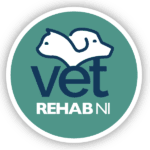Veterinary Physiotherapy
Veterinary physiotherapy is now well established as a mainstream complementary treatment, which we offer at our physiotherapy suite in Dundonald as part of our multimodal approach to treating your canine companion.
Physiotherapy Explained
Veterinary physiotherapy is a science-based profession, which takes a holistic approach to each patient by providing functional assessment following veterinary referral. Physiotherapy for dogs can be used to help in the treatment or long-term management of many musculoskeletal or neurological injuries and conditions.
It can assist rehabilitation of your dog, with the aims of reducing pain, improving movement, and restoring normal muscle control and function.
We work as a team with your vets to provide an agreed treatment plan.
Exercise Prescription: individual exercise programmes are utilised to help to encourage correct movement patterns and improve muscle strength, endurance, suppleness, proprioception (the animal’s awareness of where it’s limbs and body are in space), balance and stability as may be required.
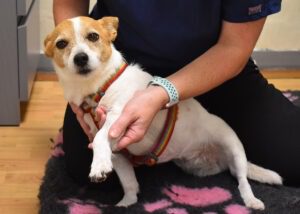
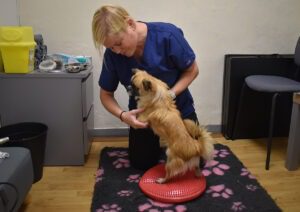
Acupuncture: The treatment involves a full musculoskeletal assessment of the patient and then placement of very fine, pre-sterilised, stainless steel needles into specific points on the body.
Often after treatment, animals exhibit behavioural changes, with improved appetite and demeanour and noticeable pain relief. Some individuals are very responsive to acupuncture and will show dramatic improvement after one treatment. The majority, however, will respond gradually over a period of time. On average, 4-6 treatments are required for the primary course. These are given weekly initially with increasing intervals progressively until the desired effect is achieved. The frequency of treatments depends on the individual animal’s needs, but regular top-ups are usually required to maintain the therapeutic effect. The needles are in for 10-20 minutes. In most cases, there is little objection to the placement.
As each treatment is specifically tailored to an individual animal, the protocol will vary. As in human medicine, approximately 20% of animals do not respond to acupuncture.
Remember – Most insurance companies cover acupuncture. You do NOT need to change your vet to use this service.
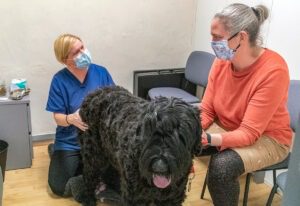
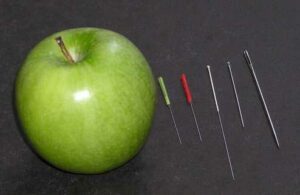
This service is provided by a fully qualified and experienced veterinary surgeon.
Acupuncture has evolved from the ancient art of placing needles into particular locations on the body to alleviate pain, improve recovery rates and increase disease resistance. It has been practised by the Chinese and other Eastern cultures for thousands of years and may treat a wide variety of illnesses.
Acupuncture also stimulates the release of pain-relieving chemicals in the brain and spinal cord( endorphins, serotonin, noradrenalin, etc.), producing more generalised analgesia. These effects, combined with local needling of painful trigger points in taut muscle bands, result in exceptional pain relief.
The western approach to acupuncture is used predominantly in treating musculoskeletal disorders and, in particular, chronic pain states in animals. The effect of acupuncture is mainly segmental: nerves, muscles, and acupuncture points are needled in the same spinal segments as the affected or painful areas. “Pain gating”, as well as descending pain inhibition (via brain and spinal cord pathways), are involved.
Medical Laser: Therapeutic Lasers and LEDs increase the speed, quality and tensile strength of tissue repair resolve inflammation and provide relief from both acute and chronic pain. Widely researched and proven effective, photobiomodulation (or laser therapy) is a valuable form of treatment for animal athletes and companion animals alike, and helps improve the quality of life for ageing pets.
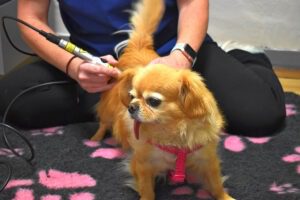
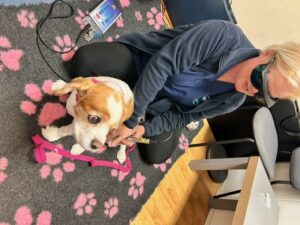
Soft Tissue Mobilisations: Soft tissue injuries, such as strains and sprains, are common. Soft tissues support organs and the musculoskeletal system and include skin, fat, muscle, nerves, tendons, ligaments, cartilage, and fascia.
Soft tissue injuries often occur when your muscles are abnormally tense, leading to problems, including:
Soft-tissue mobilization therapy is used to treat some kinds of soft tissue injuries. It’s a manual therapy intended to relieve muscle tension, reduce scar tissue and address fascial tension.
Examples include :
- pain
- muscle weakness
- a restricted range of motion
- misalignment of your skeletal system
Soft-tissue mobilization therapy is used to treat some kinds of soft tissue injuries. It’s a manual therapy intended to relieve muscle tension, reduce scar tissue and address fascial tension.
- Massage Joint Mobilisation
- Myofascial release
- Active and passive stretching
Electrotherapies: Electrotherapy includes a range of treatments using electricity to reduce pain, improve circulation, repair tissues, strengthen muscles, and promote bone growth, leading to improvements in physical functioning.
Examples of electrotherapy used include :
Therapeutic ultrasound: With an ultrasound machine, high-frequency sound waves treat injuries to muscles, tendons, and soft tissues. The sound waves pass through the skin, causing the tissues in the affected area to vibrate. This can help to improve blood flow, break down scar tissue, improve healing and decrease pain.
Neuromuscular electric stimulation (NMES): Muscle Stimulation is an artificial way of activating a muscle. Sometimes when recovering from an injury or pets suffering from arthritis, the muscles can start atrophy (waste away). The NMES can stimulate the muscles to work and gain strength without causing pain to your injury or arthritis. It mimics the impulses sent from the brain, and the muscle reacts accordingly.
TENS (Transcutaneous Electrical Nerve Stimulation): This is a very safe electrotherapy method we use in the clinic. It provides pain relief by blocking nerve signals carrying pain messages to the brain. TENS also stimulates the production of endorphins – our natural pain-relieving hormones.
PEMF is a safe, non-invasive treatment that we offer in the clinic.
Patients often enjoy the therapy and get quite sleepy during it. Treatment usually starts twice weekly and then spreads according to the patient’s needs.
The science bit…
PEMF (or Pulsed electromagnetic field therapy) uses low-level electromagnetic stimulation to stimulate the cells in our body. Every cell has polarity (like a battery), and magnets affect polarity. PEMF makes the mitochondria within our cells produce more ATP( adenosine triphosphate), which the body uses for energy. It reduces free radicals and improves the transport of ions like calcium and potassium across cell membranes, thereby improving overall cellular function.
Concerning pain PEMF changes the membrane potentials at the prostaglandin receptor sites of type C nerves reducing their effectiveness in transmitting pain signals to the brain. In recent years, researchers have confirmed that PEMF has a role in stem cell and osteogenic proliferation. PEMF is FDA-approved for stimulating bone growth and treating oedema and pain.
Scientists have been able to show:
- PEMF can reduce pain and swelling after surgery
- PEMF can reduce chronic pain
- PEMF can help with fracture healing
- PEMF can help reduce cartilage breakdown in osteoarthritis and improve the functional performance of patients after one month of therapy.
Ask in the clinic if you want to know more or book a course of treatment.
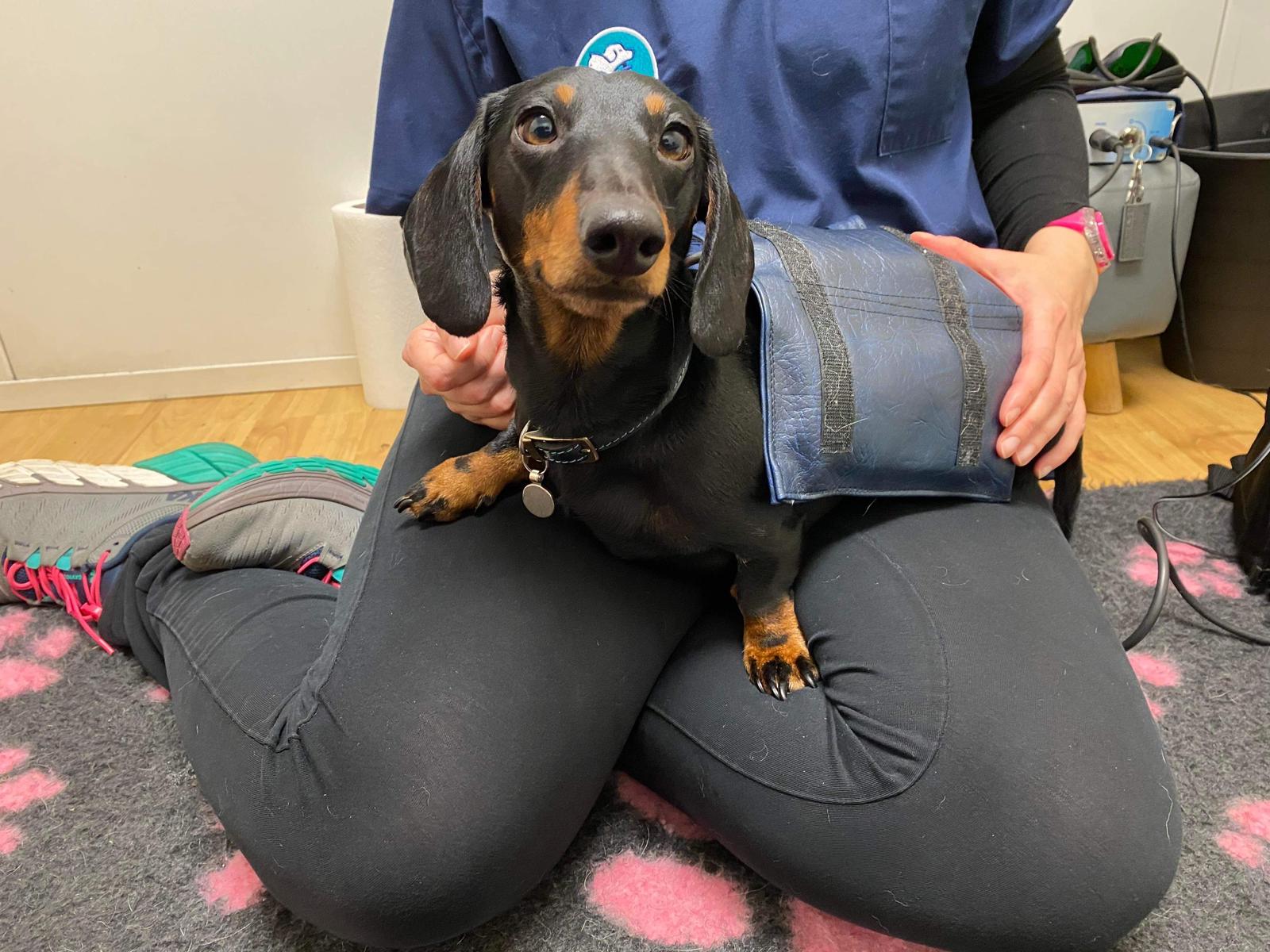
Could shockwave help your dog?
At Vet Rehab NI, we are excited to offer your pet Shockwave Therapy as a treatment for chronic pain and injury.
Shockwave therapy is a specialist treatment for chronic and painful musculoskeletal conditions. It is a procedure where (non-painful) acoustic shockwaves are passed through the skin to the injured area using a special device.
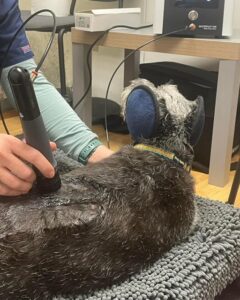
This targets the area to stimulate the body’s natural healing abilities by triggering its own repair mechanisms, including increasing blood flow to the area, reducing inflammation and the release of healing growth factors.
This can speed healing and help with long-term improvement in chronic conditions and chronic pain for 6-12 months, improving mobility and quality of life.
How is the treatment performed?
The shockwave treatment is performed in the consult room with a probe or “wand”. You can be with your pet the whole time. We wet the area, add a little gel to ensure good contact between the probe and the target area, and then move the probe over the area for a fixed amount of time. Its not sore, but it may feel a little odd at first. The machine is quite noisy, so we will make sure your pet gets used to that before we start the treatment, and we have a lovely selection of ear muffs for them to try on! It all takes a few minutes, and they can be rewarded with a lovely treat!
What should I expect after treatment?
There is often an initial pain-relieving action from the shockwave therapy, and after this wears off, your pet may be a little achy for a couple of days. The true effect takes longer and may not be seen for the first 2 or 3 treatments. We advise a rest day or 2 after each treatment to allow the treated tissues to settle down.
Shockwave can be used for:

- Osteoarthritis
- Tendon and
- Ligament injury
- Back and neck pain
- Shoulder instability
- Hip and Elbow dysplasia
- Spondylosis
Shockwave is noninvasive, so that it can be used in these conditions alongside your care program provided by your veterinary surgeon as part of your pet’s pain management and rehab plan.
Shockwave is backed by more than 10 years of veterinary and human medicine research.
Interested? Speak to our team on 02890 453936 or email info@vetrehabni.co.uk
🐶💪Paws in Motion!💪🐶
Meet Ralphie, a brave pup who’s tacking hip and elbow dysplasia like a champ! 💙 With the help of physiotherapy, he’s strengthening his joints, improving mobility, and living his best life, one step and wag at a time!🐾🌟
From hydrotherapy to targeted exercises, every movement brings him closer to comfort. Shout out to his mum for the care and dedication.🙌
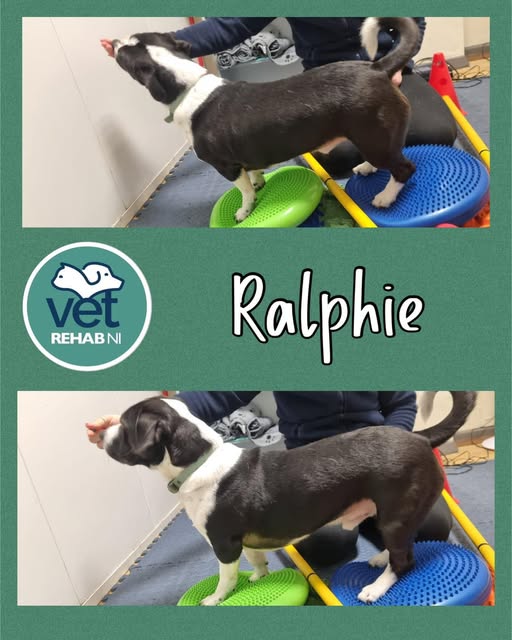
Costs
Initial Consultation from..
-
Acupuncture
-
Myofascial Release
-
Soft Tissue Mobilisations
-
Tigger Point Release & Massage
-
Remedial Exercise Programs incorporating both active and passive exercise
-
Provision of specialist knowledge to pet owner and re-education
Follow up Consultation from..
-
Therapeutic Ultrasound
-
Clinical Laser Therapy
-
Pulsed Electromagnetic Therapy
-
Strapping / Joint Support
-
TENS
-
Cryotherapy & Heat Therapy
